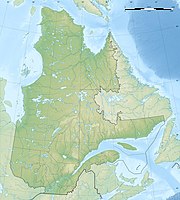Ecological Réserve Léon-Provancher
|
Ecological Réserve Léon-Provancher
|
||
| location | Bécancour , Quebec, Canada | |
| surface | 4.84 km² | |
| WDPA ID | 66620 | |
| Geographical location | 46 ° 19 ′ N , 72 ° 29 ′ W | |
|
|
||
| Setup date | 1999 | |
| administration | MDDEP | |
The Réserve écologique Léon-Provancher is a 483.8 hectare reserve established in 1999 in the south of the Canadian province of Québec , in the county of Bécancour southwest of the capital of the same name . It stretches between the north bank of Lac Saint-Paul on the St. Lawrence River opposite Trois-Rivières and autoroute 30, a trunk road. It protects a landscape typical of the area around the 353 km² Lac Saint-Pierre . This is characterized by a very large variety of plant species, with 25 of these species being considered endangered.
The relatively flat area emerged in the glacial valley of the St. Lawrence River after the Champlain Sea , a tributary of the Atlantic Ocean fed by melting glaciers, had retreated. Its deposits provide a nutrient-rich soil. The water level at Lac aux Outardes and Lac Saint-Paul is decisive for the settlement of different plant species . At the Rivière Godefroy there are pioneer plants, as well as common pond rushes ( Schoenoplectus acutus ), water rice ( Zizania palustris ), swan flower ( Butomus umbellatus ) and various types of salix such as the silky- haired willow , probably Salix glauca subsp. callicarpaea .
On the alluvial soils , i.e. young alluvial soils on the Godefroy and on the Saint-Paul-See, plant communities settle, the composition of which depends on the spring floods and the water table. There are many peat mosses , but also peat grits from the heather family , gray sedge ( Carex canescens ) or gale bush ( Myrica gale ). The willows are mostly Salix discolor and Salix petiolaris . Gray alder ( subspecies rugosa ) and red maple are more likely to be found on less humid terrain .
On the Tillit are sugar maple , Lime Tree , yellow birch ( Betula alleghaniensis ), but also very heat-loving plants such as Carya cordiformis even Hickory called a genus of trees from the family of the walnut family . The same applies to the oak species Quercus macrocarpa , which finds one of its northernmost locations here, or the Canadian hemlock , which is called Pruche du Canada here .

A total of 660 vascular plants have been recorded, many of which have their northernmost occurrence here, such as the western hackberry ( Celtis occidentalis ) or Ranunculus flabellaris from the buttercup genus , Saururus cernuus Linné from the lizard-tail family , which in turn belong to the order of the pepper-like family heard. Justicia americana (Linné) Vahl , which is called Carmantine d'Amérique here , and which belongs to the acanthus family, is one of these northernmost representatives of its kind .
In addition to the abundance of plants, the fauna also offers numerous species, such as the bald pike . He is the last member of the family of the same name and still shows characteristics of primeval bony fish. Among the insects, the butterfly Asterocampa celtis , here called Papillon du micocoulier , and the beetle from the genus Agrilus, called Agrile du micocoulier , are considered endangered . Both depend on the hackberry (French: micocoulier).
The reserve was named after Léon Provancher (1820-1892), a botanist, entomologist and founder of Le Naturaliste canadien who was born in Bécancour . He is considered one of the outstanding personalities of Canada.
Web links
- Réserve écologique Léon-Provancher , government website
Remarks
- ↑ Lézardelle penchée. Saururus cernuus Linné on the website of the responsible ministry.
- ^ Justicia americana (Linné) Vahl on the website of the responsible ministry.


